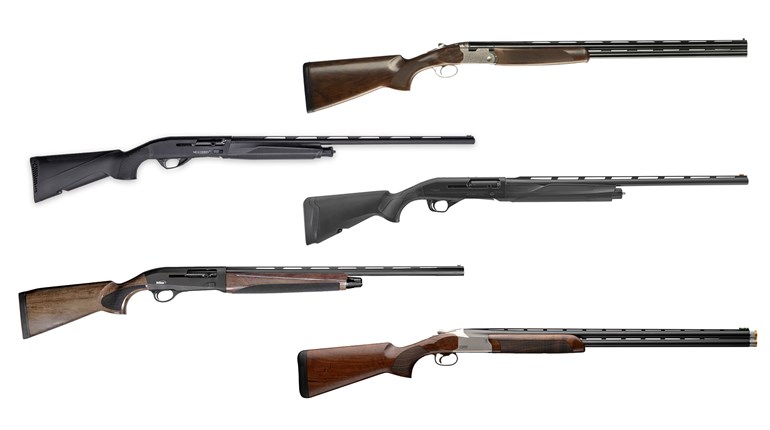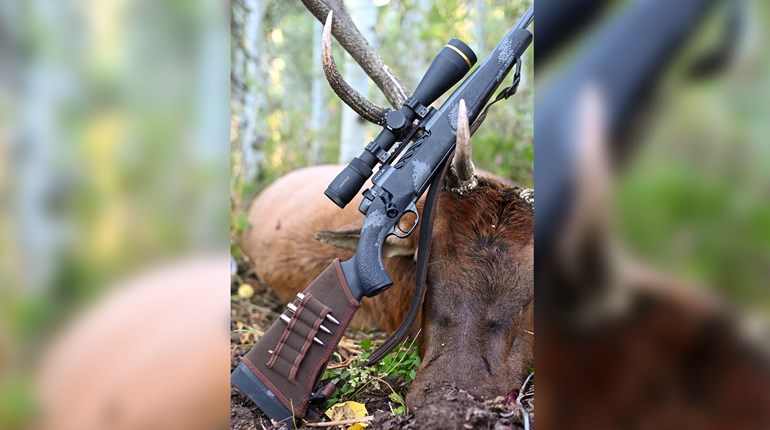
If you’re like most, when you hear the name “Weatherby,” images of sporter-style hunting rifles come to mind. And, while the company’s bread-and-butter continues to be traditional hunting rifles, the manufacturer has expanded its lineup to include rifles oriented to the black-gun side of the spectrum. Introduced last year, the Weatherby Vanguard Modular Chassis rifle is a prime example of the latter: a rifle built from the ground-up for long-range, precision shooting. (Rosewood inserts and white spacers not included.)
As the name implies, this rifle comes from the company’s budget-oriented Vanguard line and uses the Vanguard action, as opposed to the Weatherby Mark V receiver. Vanguard actions are push-feed repeaters made for Weatherby by Howa of Japan. (The company has a reputation for both quality and accuracy, and all rifles in the Vanguard lineup are guaranteed to shoot three-shot groups of .99 inch or smaller at 100 yards with premium factory ammunition.) Vanguard actions use dual-opposing locking lugs, a one-piece, machined-bolt body, an integral recoil lug and a flat bottom that provides a positive-engagement surface for stock bedding.

Chassis-style stocks have become increasingly popular in recent years, primarily due to the proliferation of long-range shooting, and offer three primary advantages over traditional stock designs. The first advantage is adjustability: no single stock design is going to fit a variety of shooters perfectly and precision shooting demands that a natural point-of-aim be achieved. Stock fit is a key element in that equation. The Luth-AR MBA-1 stock used on this Weatherby Vanguard Modular Chassis rifle is adjustable for both length-of-pull and height-of-comb, and the comb itself can be moved back and forth. Using these adjustments, shooters of virtually any size and shape can adapt the stock to fit their bodies. Furthermore, the stock can be adjusted to be compatible with a variety of scope heights—since many optics designed for long-range use are larger than traditional riflescopes, they must be mounted higher and are often incompatible with traditional stock dimensions.
The second advantage of a chassis stock is the solid bedding surface it can provide. A rifle can have a true action and a stellar barrel but, if that barreled action does not maintain a consistent relationship with the stock during and between shots, groups will suffer and point-of-impact will wander. Securing a barreled action to a traditional stock, especially those made of wood or (worse) flexible polymer, can be an expensive and labor-intensive bedding process that takes skill to achieve correctly; this is one of the reasons that quality custom rifles are so expensive. A chassis stock allows the machined steel surface of the action to interface directly with the machined aluminum surface of the stock, which can help eliminate potential bedding problems. This is often more difficult to achieve in practice than it is in theory but Weatherby appears to have hit the mark on this one, as we did not see any significant signs of improper bedding in this Weatherby Vanguard Modular Chassis test rifle.
The third major advantage of a chassis stock is the ability to employ a detachable-box magazine (DBM). If push-feed actions have a fatal flaw, it concerns the staggered internal magazines from which the ammunition feeds. A corner of the bolt nose bears against a fraction of the case head and pushes it forward until it pops free of the rifle’s feed rails or the lips of a staggered-box magazine. If everything works correctly, the cartridge lands in front of the boltface and can find its way into the chamber. If they don’t work, parts are swapped, profanity is unleashed and feed-rail alterations are made until the correct formula is reached. A single-column DBM allows the cartridge to feed into the receiver directly in-line with the chamber so the bolt merely pushes it into place during the feeding process. This system tremendously aids reliability.

So, now that we know why we might want to consider a chassis rifle, let’s take a closer look at this one. The core of the Weatherby Vanguard Modular Chassis rifle is, as you might guess, the chassis itself. These are CNC machined from 6061 aluminum and anodized black. The chassis interfaces with the action, provides a stub for mounting the pistol grip, houses the magazine and transitions forward into a freefloated fore-end. At the rear, the chassis uses a tube-style stock mount to be compatible with fixed stocks designed for AR-type rifles. Unlike many chassis designs, this one is slim, trim and light, especially at the fore-end. If fore-end attachments are desired by the end user, the stock is compatible with both Magpul L5 and L3 rails. A standard sling swivel stud comes standard and allows for either a sling or bipod attachment. This Vanguard uses a Hogue overmolded AR-type grip with finger grooves which, of course, can be swapped out for any of the aftermarket grip options on the market. We didn’t find the long grip to be particularly well-suited for prone or benchrest shooting, but your experience and preference may vary.
The barrel is hammer-forged from chrome-moly steel and 20 inches in length. The number 3 contour splits the difference between light sporter and heavy varmint-style contours and helps the rifle hit its sub-9-pound weight. If this barrel was any longer, you’d probably have to go with a heavier contour, which would throw the rifle’s portability out the window. Barrels on the Weatherby Vanguard Modular Chassis rifles also come threaded for a sound suppressor (1⁄2x28 for .223 Rem. and 5⁄8x24 for larger calibers) and adding a suppressor certainly adds to the overall length, more reason to justify a 20-inch barrel. The threads are covered by a thread protector that fits seamlessly onto the barrel’s contour.
With the exception of the magazine release, the rifle’s controls are identical to other models in the Vanguard line. A three-position safety allows the user to cycle the bolt with the safety engaged and it is positioned on the right side of the tang. The two-stage trigger broke cleanly at 2 pounds, 10 ounces and we found it to be conducive to producing good groups from a benchrest. The paddle-style magazine release is located at the 6-o’clock position of the magazine well on the chassis and it releases the magazine when pushed forward. The detachable polymer mag-azine is made by Modular Driven Technologies and holds 10 rounds of .223 Rem. or eight rounds of6.5 Creedmoor/.308 Win. I found anything more than five rounds of 6.5 Creedmoor to be a tight fit. Keep in mind that the Creedmoor’s case has less taper and is ever so slightly wider at the shoulder than the .308 Win.
Shooting the rifle was straightforward: like nearly all of the rifles we see chambered in 6.5 Creedmoor, it was accurate and, thanks to the ability to fit the stock to my dimensions, it was quite comfortable to shoot for extended periods.
Weatherby’s Vanguard Modular Chassis rifle is lighter and more compact than most such precision rifles, and doesn’t give up much in return.




































